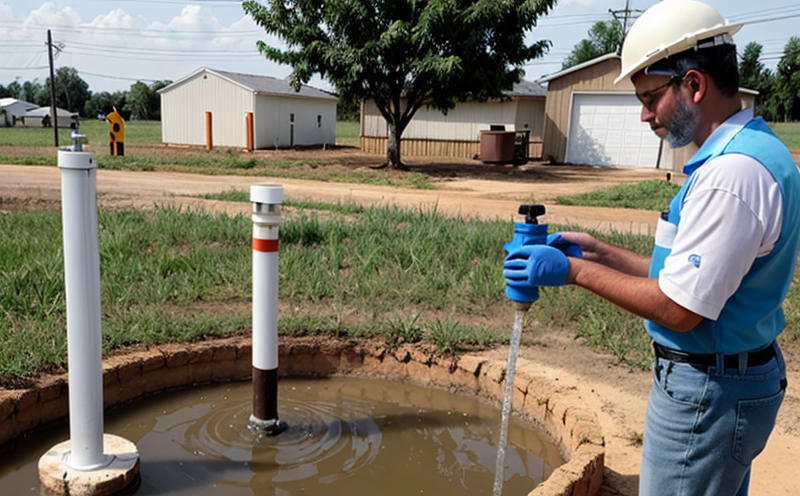ISO 10304-1 Ion Chromatography of Anions
The ISO 10304-1 standard provides a robust methodology for the quantitative analysis of anionic species in water and wastewater samples. This method is particularly valuable for quality managers, compliance officers, R&D engineers, and procurement professionals who are tasked with ensuring that groundwater meets stringent regulatory and internal standards.
The technique of ion chromatography (IC) allows for the separation of ions based on their interactions with a stationary phase in an eluent solution. This process is highly sensitive and can detect even trace levels of anions such as chloride, fluoride, bromide, nitrate, and sulfate. The precision and accuracy offered by ISO 10304-1 make it a preferred method for environmental monitoring and compliance.
The first step in the testing procedure involves the collection and preparation of groundwater samples according to specific guidelines set forth in ISO 10304-1. This includes ensuring that the sample is representative of the water body being tested, minimizing contamination, and preventing any chemical changes from occurring during storage or transport.
Once the samples are ready for analysis, they undergo ion chromatographic separation using an appropriate column packed with a stationary phase designed to retain anions. The eluent used in this process plays a crucial role in determining which ions will be detected and at what sensitivity level. After separation, the effluent from the column is monitored by a conductivity detector that quantifies the concentration of each ion present.
The results generated through ISO 10304-1 are presented as concentrations or limits for specific anions within the sample matrix. These data points contribute to comprehensive reports that help stakeholders make informed decisions regarding water quality, treatment processes, and regulatory compliance.
Compliance with local and international standards is paramount when performing groundwater analysis under ISO 10304-1 guidelines. By adhering strictly to these protocols, laboratories ensure their findings are reliable and can be trusted by all parties involved in managing public health and environmental resources.
The rigorous nature of ISO 10304-1 ensures that analysts are trained extensively on proper sample handling techniques, chromatographic setup configurations, calibration procedures, data interpretation methods, and reporting standards. Continuous improvement practices ensure that the latest advancements in analytical science are incorporated into ongoing testing methodologies.
In summary, ISO 10304-1 ion chromatography provides a reliable platform for assessing groundwater quality by detecting key anions at trace levels. Its implementation supports critical decision-making processes related to water resource management and environmental protection efforts worldwide.
Applied Standards
| Standard Number | Title | Description |
|---|---|---|
| ISO 10304-1 | Ion Chromatography of Anions - Part 1: General Principles and Guidelines for Sample Preparation, Separation, Detection, and Quantification | This standard provides comprehensive guidance on the ion chromatographic analysis of anionic species in water samples. |
| ASTM D7495-10 | Standard Practice for Collection and Preservation of Groundwater Samples for Determination of Inorganic Anions by Ion Chromatography | This practice outlines procedures for the collection, preservation, and storage of groundwater samples intended for inorganic anion analysis. |
| Standard Number | Title | Description |
|---|---|---|
| EN 15648-2:2017 | Water for Irrigation and Related Uses - Part 2: Quality Criteria | This European standard specifies quality criteria for irrigation waters, including limits for certain anions that could affect plant growth or soil health. |
| IUPAC Recommendations on Ion Chromatography | International Union of Pure and Applied Chemistry recommendations providing best practices in ion chromatographic techniques. | This document offers guidance on selecting appropriate columns, eluents, detectors, and other instrumentation used in ion chromatographic analyses. |
Benefits
The benefits of utilizing ISO 10304-1 for groundwater quality testing extend beyond mere compliance; they encompass enhanced confidence in the integrity and accuracy of analytical results. Stakeholders benefit from knowing that their decisions are based on scientifically sound data, which translates into better resource management practices.
Water utilities can leverage this information to optimize treatment processes, reduce costs associated with excessive chemical use or energy consumption, and ultimately improve customer satisfaction by delivering cleaner drinking water. In industries reliant on groundwater resources for production purposes, compliance ensures continued access to reliable supplies without fear of legal repercussions.
For regulatory bodies responsible for enforcing environmental protection laws, consistent application of ISO 10304-1 helps maintain public trust in government oversight mechanisms while fostering cooperation between industry and government agencies. This collaborative approach encourages sustainable practices that protect both human health and ecosystems dependent on clean water sources.
In summary, ISO 10304-1 ion chromatography offers a powerful tool for assessing groundwater quality, ensuring compliance with relevant standards, and driving informed decision-making across various sectors.
Customer Impact and Satisfaction
Customers who choose our ISO 10304-1 ion chromatography services experience significant improvements in their ability to meet regulatory requirements and maintain high-quality standards for their water resources. Our laboratory adheres strictly to international guidelines, ensuring accurate and reliable results every time.
We work closely with clients from diverse industries including municipal water supply companies, agricultural businesses, industrial facilities, and environmental consulting firms. By providing timely reports based on ISO 10304-1 methodologies, we enable these organizations to take proactive measures towards maintaining sustainable practices.
Our commitment to excellence is reflected in the satisfaction levels of our customers. Positive feedback from past projects demonstrates that stakeholders appreciate the depth of knowledge and expertise brought to bear during each project phase—from initial consultation through final reporting.
In addition, our ongoing research initiatives focused on advancing chromatographic technologies ensure that we remain at the forefront of innovation within this field. This dedication allows us to offer state-of-the-art solutions tailored specifically to meet individual client needs.





